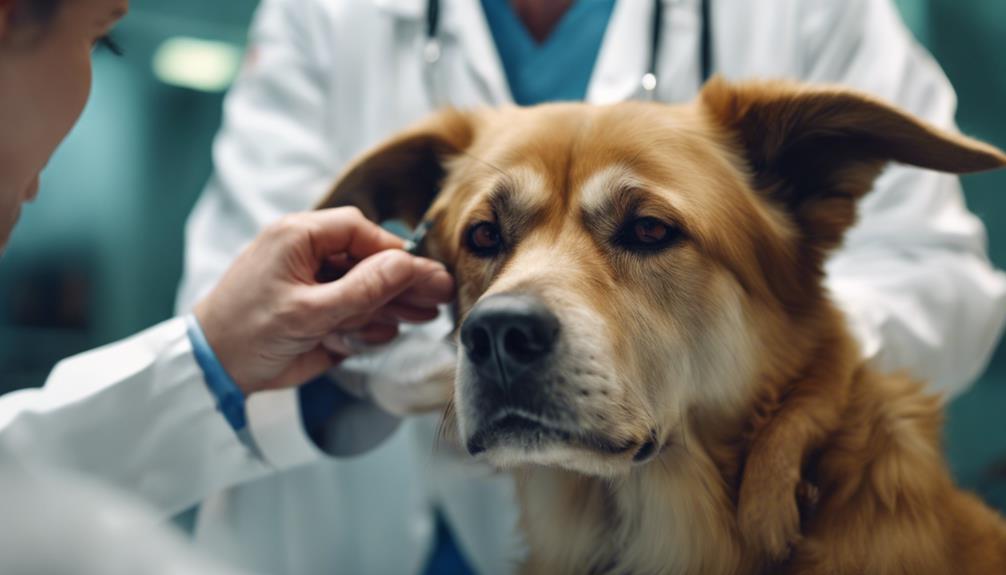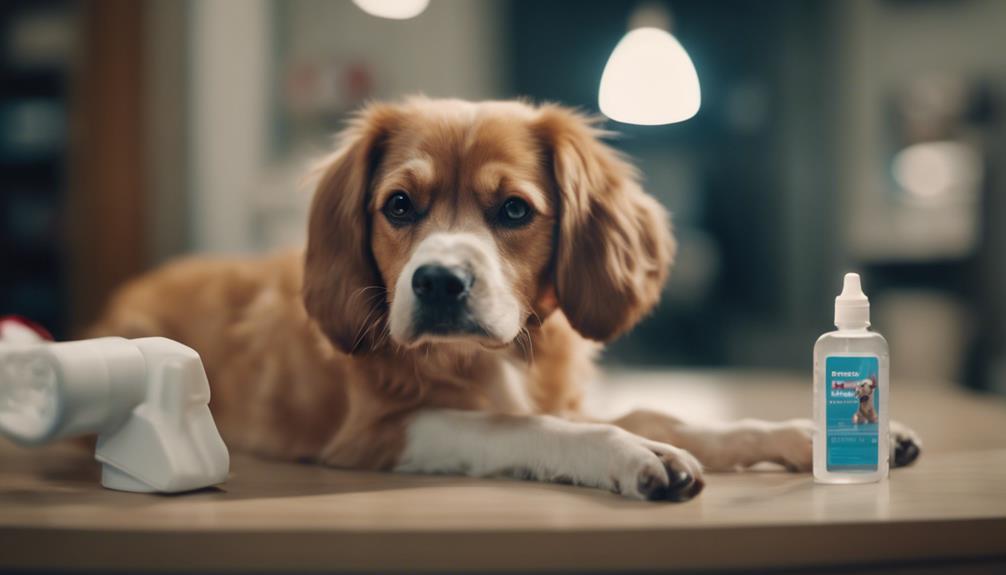In the realm of veterinary care, understanding the nuances of canine health is crucial for responsible pet ownership.
When it comes to the possibility of a yeast infection in dogs, the signs may not always be straightforward. From subtle behavioral changes to visible symptoms, being attuned to your dog's well-being is paramount.
However, beyond mere observation lies a realm of proactive measures and specific actions that can make a substantial difference in your pet's health.
By exploring the intricacies of potential yeast infections in dogs and knowing what steps to take, you can empower yourself to provide the best possible care for your furry companion.
Key Takeaways
- Regular vet check-ups help diagnose and treat potential yeast infections in dogs effectively.
- Proper diagnosis is crucial for determining the severity and appropriate treatment of yeast infections.
- Consistent use of prescribed topical treatments like ear washes and shampoos is essential for clearing infections.
- Preventing underlying health issues and allergies can help reduce the risk of recurrent yeast infections in dogs.
Recognizing Signs of Dog Yeast Infections
Identifying the telltale signs of dog yeast infections is essential for prompt diagnosis and treatment. Common indicators include persistent itching, redness, greasy or crusty skin, foul odor, and dark discoloration in skin folds.
Dogs with yeast infections may excessively scratch, lick, or chew at affected areas, leading to hair loss and skin irritation. Ear infections manifest through head shaking, ear discharge, and a strong musty smell. Paw licking and scooting are also signs of potential yeast infections.
Prompt recognition of these symptoms is crucial in seeking veterinary care to prevent the infection from worsening. Early intervention with appropriate treatment can alleviate discomfort and prevent complications associated with dog yeast infections.
Factors Contributing to Yeast Infections
Various factors contribute to the development of yeast infections in dogs, ranging from underlying medical conditions to environmental triggers. These factors can create an environment conducive to yeast overgrowth, leading to infections that can cause discomfort and irritation to the dog.
To understand the potential causes of yeast infections in dogs, consider the following:
- Imbalanced Diet: Diets high in carbohydrates can promote yeast growth.
- Weakened Immune System: Dogs with weakened immune systems are more susceptible to yeast infections.
- Moisture and Warmth: Humid environments and lack of proper ventilation can encourage yeast proliferation.
- Medications: Certain medications like antibiotics and steroids can disrupt the natural balance of yeast on the skin and mucous membranes.
Understanding Diagnosis and Treatment Options

What are the key considerations for diagnosing and treating dog yeast infections effectively? When diagnosing a dog yeast infection, microscopic analysis of a sample from the affected area is crucial. Complications may arise if bacterial infections or skin mites are present. Treatment approaches vary based on the severity of the infection, with options including antifungal pills and topical products. Severe cases might require a combination of treatments for effective clearance. Proper treatment is essential to combat the infection successfully. To provide a clearer overview, here is a table summarizing the key considerations for diagnosing and treating dog yeast infections:
| Consideration | Description |
|---|---|
| Diagnosis method | Microscopic analysis of affected area sample |
| Complications | Coexistence of bacterial infections or skin mites |
| Treatment approaches | Antifungal pills, topical products |
| Severity | Determines treatment intensity |
| Combination treatments | Necessary for severe cases |
Importance of Proper Medication Use
In ensuring the effective management of dog yeast infections, the proper use of medications plays a critical role in addressing the condition and promoting the well-being of the animal. Utilizing medications correctly can help alleviate symptoms, eradicate the yeast overgrowth, and prevent recurrence.
To ensure the proper medication use:
- Follow Vet Instructions: Adhere strictly to the dosage and application instructions provided by the veterinarian.
- Complete Treatment Course: Finish the entire medication course even if symptoms improve to prevent the development of resistance.
- Monitor for Side Effects: Watch for any adverse reactions and promptly inform the vet if any occur.
- Store Medications Properly: Keep medications in a cool, dry place away from children and pets to maintain their effectiveness.
Addressing Ear Yeast Infections Effectively

When addressing ear yeast infections in dogs, thorough cleaning and targeted medication application are essential components of effective treatment. Cleaning the ears with a vet-approved medicated wash is crucial to remove excess yeast and debris.
After cleaning, applying prescribed antifungal ear ointments directly into the ear canal helps combat the yeast overgrowth. Consistent and proper application of medication is key to achieving successful outcomes. It is important to follow the veterinarian's instructions carefully, including the frequency and method of application.
Additionally, monitoring the dog for any signs of discomfort or worsening symptoms during the treatment process is recommended. By adhering to these steps diligently, ear yeast infections in dogs can be addressed effectively.
Managing Skin Yeast Infections Correctly
Proper management of skin yeast infections in dogs requires a systematic approach encompassing thorough cleansing and targeted application of prescribed antifungal products. When dealing with skin yeast infections, it is essential to follow specific steps for effective treatment:
- Cleanse Affected Areas: Begin by cleaning the infected skin thoroughly to remove excess yeast and debris.
- Apply Antifungal Products: Use prescribed antifungal medications such as creams, lotions, or sprays directly on the affected areas.
- Follow Vet Instructions: Adhere strictly to the veterinarian's instructions regarding the frequency and method of applying the antifungal products.
- Monitor Progress: Regularly monitor the skin's response to treatment and consult the vet if any changes or concerns arise.
Preventive Measures for Yeast Infections

For dog owners seeking to proactively safeguard their pets from yeast infections, prioritizing preventive measures is paramount to maintaining their canine companions' skin health and overall well-being. Here are some key preventive measures that can help in reducing the risk of yeast infections in dogs:
| Preventive Measures | Description |
|---|---|
| Regular ear cleaning | Using vet-approved products to prevent ear infections |
| Allergy management | Timely addressing of allergies can help prevent yeast infections |
| Veterinary consultation | Identifying and treating underlying diseases for prevention |
Role of Veterinary Consultation in Treatment
The pivotal role of veterinary consultation in the effective treatment of dog yeast infections cannot be overstated. Veterinary expertise is essential for accurate diagnosis, personalized treatment plans, and monitoring the progress of the infection.
Here are four crucial reasons why consulting a vet is paramount in treating dog yeast infections:
- Accurate Diagnosis: Vets can conduct necessary tests to confirm the presence of yeast infections and rule out other underlying issues.
- Tailored Treatment Plans: Veterinarians can recommend specific medications, topical treatments, and cleaning routines based on the severity and location of the infection.
- Monitoring and Adjustments: Regular check-ups allow vets to monitor the dog's response to treatment and make any necessary adjustments for optimal results.
- Preventive Guidance: Vets can identify predisposing factors and offer advice on preventing future yeast infections through proper care and management.
Caution With Herbal Remedies

Exercise caution when considering herbal remedies for treating dog yeast infections, particularly in light of their potential risks and limitations.
While some herbal remedies may offer benefits, they can also pose risks if not used correctly. Herbal treatments like tea tree oil, for example, can be toxic to dogs if ingested and should be diluted for external use only.
Additionally, the effectiveness of herbal remedies in treating yeast infections may vary, and they might not provide the same level of efficacy as prescribed medications.
It is crucial to consult with a veterinarian before using any herbal remedies to ensure they are safe for your dog and will not interfere with other treatment methods.
Potential Complications to Watch For
Monitoring for potential complications is essential when managing dog yeast infections to ensure effective treatment outcomes. These complications can hinder the healing process and impact your pet's well-being. It's crucial to stay vigilant and address any issues promptly to prevent further complications.
Here are some potential complications to watch for:
- Secondary Infections: Watch for the development of bacterial infections alongside the yeast infection, which can complicate treatment.
- Chronic Inflammation: Persistent yeast infections can lead to chronic inflammation in the affected areas, causing discomfort for your dog.
- Resistant Strains: Prolonged or improper use of antifungal medications can contribute to the development of resistant yeast strains.
- Systemic Spread: In severe cases, yeast infections can spread systemically, affecting internal organs and requiring more aggressive treatment approaches.
Long-Term Management and Prevention

Implementing a comprehensive care plan is essential for the long-term management and prevention of dog yeast infections. Regular veterinary check-ups are crucial to monitor your dog's condition and ensure early detection of any recurring infections.
Maintaining a clean environment and proper hygiene practices can help prevent the overgrowth of yeast. Consistent grooming, including regular ear cleaning with vet-approved products, is vital in reducing the risk of ear infections.
Addressing underlying health issues promptly, such as allergies or hormonal imbalances, can also play a significant role in preventing yeast infections. Following your vet's recommendations for diet, medication, and hygiene routines tailored to your dog's specific needs is key to preventing future occurrences of yeast infections.
Conclusion
In conclusion, recognizing the signs of dog yeast infections, understanding contributing factors, and seeking proper diagnosis and treatment are crucial steps in ensuring your pet's well-being.
Utilizing medication correctly, addressing ear infections effectively, and consulting a veterinary professional can help in managing and preventing yeast infections.
It is important to exercise caution with herbal remedies and be aware of potential complications that may arise.
Long-term management and proactive measures are key to safeguarding your dog's health.




